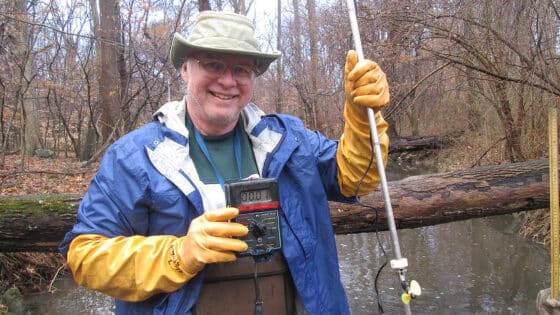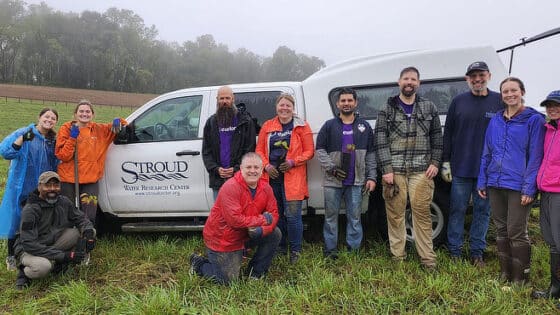Remembering Ruth Patrick (1907-2013)
eDNA Could Help Build Mussel Strength in Streams
By Diane Huskinson
Small and inconspicuous in their native habitat, mussels are, at first glance, perhaps the most humble of freshwater species. But in fact they yield great power in preserving and restoring streams and rivers. A single mussel can filter up to eight gallons of water a day. During their relatively long lifecycles, indeed for some species as long as those of humans, they accumulate suspended sediments and nutrients that would otherwise contaminate waterways.
“A hundred years ago, there were eight species of freshwater mussels between the White Clay, Red Clay, and Brandywine creeks. Now there are now only two — that we know of,” says Assistant Research Scientist William Eldridge, Ph.D., “Pollution, the loss of fish hosts, invasive species, and other changes have made them one of the most threatened organisms on Earth.”
That’s significant and gives merit to the intentional protection of mussels. Protection, however, means finding them first — easier said than done since their earthy, murky colors suit as camouflage better than battle fatigues on soldiers.
The Future of Aquatic Species Monitoring
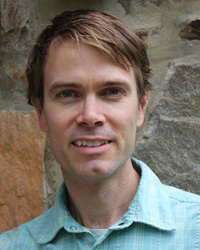
So Eldridge is taking a novel approach to confirming the presence of freshwater mussels in the Delaware Estuary. And it’s one that promises to be much more reliable than the standard visual surveys. In a twist that mirrors his own career, Eldridge won’t be looking for mussels at all, at least not initially. A fish molecular ecologist in practice and a human geneticist by training, Eldridge will utilize his unique blend of skills to instead sample stream water and identify mussels by their DNA.
It’s called environmental DNA, or eDNA, and according to Eldridge, it’s the future of aquatic species monitoring.
“It’s in its infancy,” he says, “but we’re not far away from getting a snapshot of all aquatic life in a stream just by analyzing a single sample of stream water.”
Most eDNA aquatic work is done in stagnant bodies of water, such as lakes and ponds, where more DNA can accumulate and increase the likelihood of detection. Rivers and streams, on the other hand, are constantly flushing, so DNA concentrations are lower. Therein lies the challenge.
“Our focus will be on sensitivity. How much DNA must be collected to detect mussels? And then specificity to determine if we get false positives; we don’t want to mistake mussel DNA for other species with similar DNA sequences,” Eldridge explains.
If it works as Eldridge hopes, at the end of the study, scientists will have a technique for finding mussels that is cheap and effective.
Confirming the Results
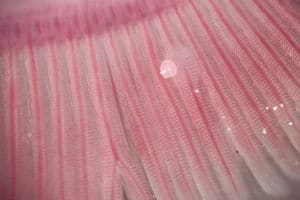
“eDNA is a great tool, but we’ll be conducting additional surveys to locate individual mussels and confirm they are alive.” Stroud Water Research Center’s Entomology Group and citizen monitors with the Delaware Nature Society and The Partnership for the Delaware Estuary will aid in mussel surveys following Eldridge’s DNA analyses.
“We’ll also be testing for glochidia, a juvenile stage of freshwater mussel that attaches to a fish host. If glochidia are present, then we know there are adults that are reproducing. That would be a good sign. As we find glochidia on various fish species, we’ll also determine which fish they can use as hosts.”
The study, which will run through December, is being funding with a grant from Clear into the Future®, a community-based, corporately sponsored conservation program of DuPont.
A Stroud and NWF Partnership Helps More Students Connect With Nature
By Diane Huskinson
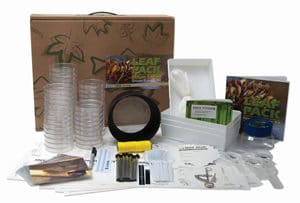
Eager for the chance to get their hands dirty, students across the country and beyond are discovering the important relationship between streamside forests and healthy waterways.
Developed by Stroud Water Research Center scientists in the 1990s, the Leaf Pack Experiment Stream Ecology Kit is a hands-on water-quality testing tool that uses leaf litter and insect identification to assess biodiversity and reveal what makes streams healthy or unhealthy. Now, even more students and teachers will connect with nature as Stroud Water Research Center and National Wildlife Federation (NWF) partner to deliver the kits throughout North America.
From Scientists to Teachers and Students
Since the 1960s, Center scientists have used leaf litter to assess water quality in streams. The Leaf Pack Experiment Stream Ecology Kit has been designed to help students use the same method. Mesh bags filled with leaf litter are placed in streams and retrieved a few weeks later to look for the presence of aquatic insects. By taking inventory of which bugs are breaking down the packs of leaves, students can evaluate a stream’s water quality and monitor the long-term health of their own watersheds.
“Every stream has a story,” said Christina Medved, the Center’s education programs manager and Leaf Pack Network® administrator, “Leaf Pack takes students outside to investigate their local streams, where they uncover these stories in the same way our scientists do.”
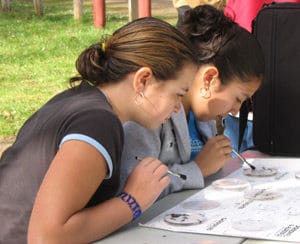
Bob Connick, a teacher at Mahopac High School in New York, relies on the Leaf Pack Experiment to teach his students the scientific method and problem solving: “Leaf Pack is probably the closest thing to real science as students can get. It renews their sense of wonder and curiosity about nature.
Making the Discovery on Their Own
“One of the most significant lessons students learn from Leaf Pack is that stream health is intimately connected to the presence of trees along stream banks. I can tell students this, but they’ll more fully understand it by making the discovery on their own,” said Connick, who has conducted annual Leaf Pack experiments with his students for nearly a decade.
After conducting their own Leaf Pack Experiment, schools can share data through the Leaf Pack Network®. By adding their own data, students participate in a wide network that provides a snapshot of water quality in streams and rivers throughout North America. On local, regional, and national scales, they can see the connection between streamside forests and the ecology of rivers and streams.
To purchase a Leaf Pack Experiment Stream Ecology Kit for your school or to gift one, visit the LPN equipment page.
Staff Spotlight: Sherman Roberts and Michael Gentile
By Diane Huskinson

Ask anyone at Stroud Water Research Center what makes working here great, and most often you’ll hear that it’s the people.
“We’re like a family,” says staff scientist Sherman Roberts. Many of those who call the Center home, Roberts included, have had lifelong careers here.
While mission matters, it’s the people who make the Center’s research and related endeavors successful. “We’re fortunate to have a core group of scientists, researchers, educators, administrative personnel, and support staff all working together for, in many cases, decades,” Roberts says. “There’s a cohesiveness here that comes from having individuals with so much expertise in the work we do here.”
Not counting senior scientists, the aggregate of experience among the current technical staff is over 150 years.
Roberts joined the Center’s staff in 1972, and he’s been working alongside friend and colleague Mike Gentile, also a staff scientist, since Gentile was hired in 1997.
Working Behind the Scenes
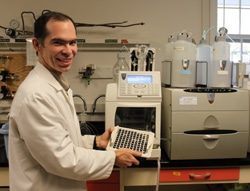
As researchers often do, Roberts and Gentile work behind the scenes, keeping the labs running and processing multitudes of samples for some of the most notable projects in Stroud Water Research Center history such as the metaecosystems project.
And they’ve both traveled as far as Costa Rica in the name of Stroud science — Roberts five times and Gentile, 15.
Friends As Well As Colleagues
Of Gentile, Roberts says he not only performs cutting-edge analyses, but he is also an expert at maintaining and upgrading many of the Center’s instruments. “He’s tenacious in working through the many challenges that confront us — sometimes on a daily basis. I am fortunate to have him as a co-worker and a friend.”
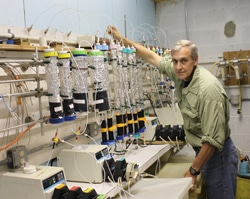
Of Roberts, Gentile says he’s “reliable and dependable. He has a sense of humor. He’s confident. He’s a good problem solver. And we have a good time together.”
Married to wife Eleanor for 32 years, Roberts has a son Christopher, who is studying at American University. He and his wife live in Springfield, Pa.
Gentile and his wife of thirteen years, Susan, have two children: Connor (nine) and Cameron (three). They live in Oxford, Pa.
An Evening in Review: Chasing Ice
By Diane Huskinson
On the heels of a massive 1,000-year flood event, Jeff Orlowski left his home in Boulder, Co., precariously still intact, and traveled cross-country to introduce his film about climate change to a sold-out crowd. As director and producer of the highly acclaimed, award-winning film Chasing Ice, featured as this year’s Joan and Dick Stroud Memorial Lecture, Orlowski saw firsthand the consequences of climate change.

Originally, he was hired as a videographer by James Balog, a National Geographic photographer on a mission to document some of Earth’s most beautiful icy landscapes rapidly melting away. But as the story of the photo project began to unfold, Orlowski realized he had the makings of a great film.
When he addressed Stroud Water Research Center’s 300 plus guests at Winterthur on Sept. 15, he described many challenges in the making of Chasing Ice: extreme cold he and the rest of the team battled, including sub-0 temperatures with no heat, and death-defying moments on the icy cliffs. But what kept them going, he said, was their faith in the project. It was, unquestionably, a story that needed to be told.
The stunning imagery of Chasing Ice, combined with the startling rate at which the film shows glaciers melting into rising sea waters, left audience member Reeve Draper saying, “It’s an incredibly powerful film. Technology has advanced so much that, to a certain extent, we’ve lost the ability to be awestruck by what photographers can capture. This film reminds us what it takes, on a human level, to get those images. I think it’s going to blow the public’s mind.”
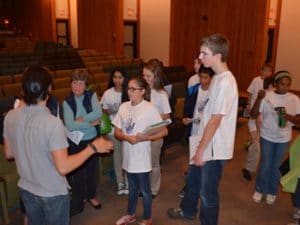
Jolie Chylack, who brought a group of students in 6th through 7th grade from the Kids Leadership Academy, said, “We brought the students because they’re interested in taking care of the environment. Jeff Orlowski is a hero to our students. He started young and went after his passion, and he’s making climate change accessible to people who don’t have science backgrounds.”
One student in Chylack’s group voiced the call of an eager generation: “It’s kind of scary, but it motivates you to do what you can to make a difference.”
For Stroud Water Research Center, the film’s message is important because, as Director Bern Sweeney said when introducing the film, “Climate change impacts water quality.”
The Joan and Dick Stroud Memorial Lecture Series, sponsored this year in part by Calico, is held in honor of Joan’s commitment to education. Stroud Water Research Center thanks everyone who attended.
In the News
Bern Sweeney Receives 2013 Forest Champion Lifetime Achievement Award
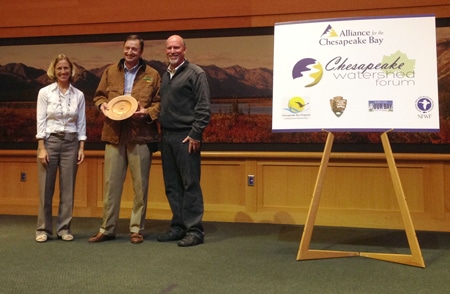
Stroud Water Research Center Director Bern Sweeney, Ph.D., received the 2013 Forest Champion Lifetime Achievement award from the Alliance for the Chesapeake Bay and the U.S. Forest Service at the Chesapeake Watershed Forum held at the National Technical Training Center in Shepherdstown, W.Va.
The conference, held Sept. 27-29 and attended by nearly 500 conservationists, scientists, and educators, celebrated 30 years of the Chesapeake Bay restoration effort. The award recognized the outstanding effort of Bern Sweeney throughout his career to conserve, restore, and celebrate Chesapeake forests in order to improve the quality and health of the Chesapeake Bay.
At the ceremony, Sweeney was recognized for his landmark scientific publications during the past three decades regarding the role that streamside forests play in the quality of water in streams, rivers, and estuaries.
He was also recognized for organizing the planting of over 100,000 trees in a variety of large field experiments throughout the mid-Atlantic region. The publication of data associated with these pioneering experiments contributed significantly to the current technology used to create streamside forest buffers to protect and enhance water quality in the Chesapeake Bay watershed.
Stroud Scientists and Educators Present
Fish Get Stressed Too
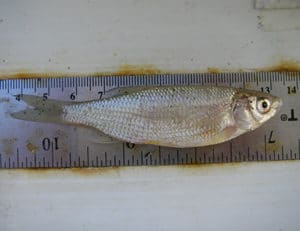
Stream temperature naturally cycles throughout the day, therefore, warming will initially lead to temperature that is stressful to fish for only part of the day. Assistant Research Scientist William Eldridge, Ph.D. has developed a model to predict stress response in fish to natural temperature fluctuations. He attended the American Fisheries Society Annual Meeting, held Sept. 8-12, 2013 in Little Rock, Ark., to present “Evaluating Four Fish Species for Stress Caused By Intermittent Exposure to Warm Temperature.”
Students Learn About Water Quality Challenges in Dry Region
Freshwater resources are necessary for meeting social, economic, and environmental needs, and the sustainable management of these resources is even especially pressing in dry regions of the United States, such as the Central Great Plains. Associate Research Scientist Melinda Daniels, Ph.D., studies the effects of agriculture, climate, and culture on water quality and availability in the Great Plains. On Sept. 13, 2013, she presented “Coupled Climate, Cultivation, and Culture in the Great Plains: Understanding Water Supply and Water Quality in a Fragile Landscape” at the University of Delaware Department of Geography Seminar Series.
Navigating the Waters of Stream Restoration
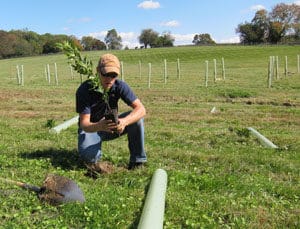
Around the world, high water quality is observed in streams draining predominately forested watersheds. Where forests have been lost, streams show a reduction in biodiversity, increased water temperatures, changes in stream shape, and increases in dissolved and particulate chemicals.
On June 22, 2013, Assistant Director Dave Arscott gave a lecture at the Virginia Working Landscapes Workshop at the Smithsonian Conservation Biology Institute, Front Royal, Va. He described how restoring forested stream buffers to improve stream water quality and stream function requires an understanding of the appropriate tree species, their growth and survivorship, competitive interactions with native and invasive species, minimizing damage from other pests, and the space needed for optimal buffer performance.
Jackson Presents Phosphorus and Long-Term Study Results
Stroud Center scientists have observed that when phosphorus is added to artificial stream channels, algae growth increases significantly. Macroinvertebrate communities showed change to a lesser extent. John Jackson presented these findings at the USEPA Region III 2013 Regional Technical Advisory Group Meeting in September.
In October, Jackson attended the 13th Annual Conservation District Watershed Specialist Meeting in State College, Pa. hosted by the PA Association of Conservation Districts. Based primarily on the Center’s long-term studies of Schuylkill River tributaries, Jackson’s presentation described the relationship between stream condition and well-known land and water uses, and evidence of environmental improvement due to regulatory and restoration efforts.
Watershed Restoration Group Shares News and Research
Director of Watershed Restoration Matt Ehrhart has been hard at work sharing the latest news and research on improving water quality through watershed restoration. On August 25, 2013, he gave a presentation on the PA Conservation Reserve Enhancement Program (CREP) for the Chesapeake Bay Commission Citizens Advisory Committee in Lancaster, Pa.
He gave two presentations at the Alliance for the Chesapeake Bay’s Chesapeake Forum in Shepherdstown, W.Va.: on Sept. 27, “Raising the Bar for Restoration Projects” and on Sept. 28, “Model My Watershed® and WikiWatershed. Finally, on Oct. 3, he gave a presentation on total maximum daily loads and the Chesapeake Bay for a group of environment-related majors at Penn State University.
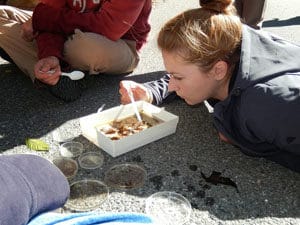
Medved Leads Stream School Workshop
In September, Education Programs Manager Christina Medved headed to New Jersey to teach two-day Stream School workshop to about 20 AmeriCorps Watershed Ambassadors at Stokes State Forest.


